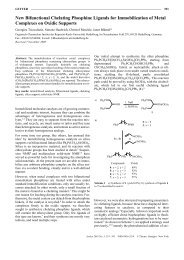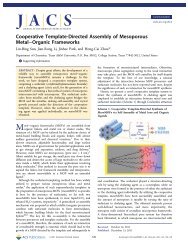Singlet Fission - Department of Chemistry
Singlet Fission - Department of Chemistry
Singlet Fission - Department of Chemistry
You also want an ePaper? Increase the reach of your titles
YUMPU automatically turns print PDFs into web optimized ePapers that Google loves.
T Chemical Reviews, XXXX, Vol. xxx, No. xx Smith and Michl<br />
singlet fission and fusion are expected. It is likely that many<br />
covalently linked dimers will fall into this category, and one<br />
will thus lose a valuable tool for proving that singlet fission<br />
is occurring. The larger the energy differences become, the<br />
stronger the two constituent triplets will be bound to each<br />
other and the harder it will be for them to act independently.<br />
There clearly is a continuous transition from the cases <strong>of</strong><br />
relatively weak triplet-triplet interaction that we have dealt<br />
with so far to a case <strong>of</strong> interaction so strong that one needs<br />
to think in terms <strong>of</strong> molecular singlet, triplet, and quintet<br />
states that do not easily interconvert. In cases in which singlet<br />
fission is isoergic or exoergic, Hss could then play the role<br />
that is ordinarily reserved for the spin-orbit coupling<br />
Hamiltonian Hsoc and convert an initially excited S1 state<br />
into long-lived excited states <strong>of</strong> higher multiplicity. Because<br />
Hss is a tensor <strong>of</strong> rank two, these could be not only triplets<br />
but also quintets. To our knowledge, such behavior has never<br />
been reported, but this may simply be a consequence <strong>of</strong> the<br />
fact that very few strongly coupled dimers or oligomers in<br />
which singlet fission would be isoergic have been investigated.<br />
It is also possible that excited quintet states <strong>of</strong> closedshell<br />
ground state molecules have already been produced but<br />
not noticed.<br />
Density Matrix Treatment<br />
As already noted repeatedly, the neglect <strong>of</strong> coherences in<br />
the time development <strong>of</strong> the 1 (TT) state is a poor approximation.<br />
Although the qualitative features <strong>of</strong> the description we<br />
have provided are valid, a quantitative treatment requires the<br />
use <strong>of</strong> the density matrix formalism. This was first developed<br />
by Johnson and Merrifield 17 and subsequently greatly<br />
improved by Suna. 18 An important conclusion reached by<br />
Suna is that the rate constants k2 and k-1 should not be given<br />
separate significance and that only their ratio, the branching<br />
factor ε ) k2/k-1, has a physical meaning. A useful summary<br />
is available 1 and will not be repeated here.<br />
Quenching <strong>of</strong> Triplets by Spin 1/2 Particles<br />
In concluding section 2.2.2, we noted that a third factor<br />
important for the development <strong>of</strong> an optimal singlet fission<br />
sensitizer for solar cells, namely, the independent use <strong>of</strong> both<br />
triplets for charge injection, still remains to be addressed in<br />
any detail. So far in this section, we have emphasized the<br />
need to minimize the energy differences between the singlet,<br />
triplet, and quintet components <strong>of</strong> the correlated triplet pair<br />
on chromophores A and B. This requires a weak coupling<br />
between the two chromophores.<br />
The contradiction between the need for a strong coupling<br />
in order for singlet fission to be fast and simultaneously for<br />
a weak coupling in order for the resulting triplets to be<br />
independent is only apparent, because the word “coupling”<br />
is being used to describe two different kinds <strong>of</strong> interactions.<br />
The expression for the matrix element that<br />
controls the rate <strong>of</strong> singlet fission by the direct mechanism<br />
is entirely different from expression 18 that controls the<br />
diagonal contribution to the splitting <strong>of</strong> the S, T, and Q states.<br />
The interactions mediated by the charge transfer states also<br />
differ, and it might well be possible to maximize the rate <strong>of</strong><br />
singlet fission while minimizing the splitting <strong>of</strong> the S, T,<br />
and Q states. The situation is reminiscent <strong>of</strong> the very different<br />
structural requirements for the optimization <strong>of</strong> the direct and<br />
the mediated singlet fission mechanism discussed in section<br />
2.2.2. So far, this issue does not seem to have received<br />
attention in the literature.<br />
However, there is another factor to be considered in the<br />
process <strong>of</strong> effecting two independent double charge separations<br />
from the triplet pair TA + TB produced by singlet<br />
fission. This factor may play a role in molecular dimers,<br />
oligomers, and small aggregates or even crystals, as long as<br />
the triplets remain in physical proximity and do not separate<br />
entirely, say by hopping apart in a crystal. Once the first<br />
injection <strong>of</strong> an electron or a hole into an acceptor has taken<br />
place, say from chromophore A, this chromophore will carry<br />
a hole or an excess electron. Such spin 1/2 particles have<br />
been long known 91-96 to quench triplet excitons in molecular<br />
crystals at a magnetic field-dependent 97-99 rate. If the triplet<br />
on chromophore B is to produce a charge separation as well,<br />
it is important to remove the spin 1/2 particle very rapidly<br />
by charge transfer, since otherwise electrostatics will be<br />
unfavorable for the second charge separation. If this cannot<br />
be achieved fast enough, at least one should make sure that<br />
the coupling between A and B is weak and the quenching<br />
process is slow.<br />
Triplet quenching by spin 1/2 particles is a large subject,<br />
and its magnetic field dependence is merely a side issue for<br />
our major topic, singlet fission. It will not be treated<br />
exhaustively here, and the reader is referred elsewhere for<br />
an early review. 1 However, because it may be <strong>of</strong> some<br />
relevance for the use <strong>of</strong> singlet fission in solar cells, a brief<br />
note appears appropriate.<br />
The initial triplet and doublet can couple to a quartet and<br />
a doublet. The final state is a doublet, and the quenching<br />
therefore represents a special case <strong>of</strong> spin-allowed internal<br />
conversion. Since Hspin has the ability to mix doublets and<br />
quartets in a way that depends on magnetic field because <strong>of</strong><br />
the presence <strong>of</strong> the Zeeman term, the overall rate <strong>of</strong><br />
quenching that starts with a statistical occupancy <strong>of</strong> triplet<br />
and doublet sublevels is field-dependent. A detailed analysis<br />
shows that the rate decreases with increasing magnetic field.<br />
To obtain an idea <strong>of</strong> the structural dependence <strong>of</strong> the<br />
quenching rate, one can evaluate the matrix element <strong>of</strong> the<br />
total electronic Hamiltonian Hel between the initial and final<br />
states. We first assume that the double-triplet state has<br />
injected an electron from chromophore A, which has thus<br />
become a radical cation. The initial state D + 1/2 in the quenching<br />
process is a doublet obtained by combining the remaining hB<br />
f lB triplet excitation on chromophore B with an unpaired spin<br />
hole left in the hA orbital <strong>of</strong> chromophore A. Its +1/2 spin<br />
component will be approximated as 6 -1/2 (|hBRlBhAR| +<br />
|hBlBRhAR| - 2|hBRlBRhA|). The final state G + 1/2 is the ground<br />
state <strong>of</strong> the system, and its +1/2 spin component will be<br />
approximated as |hBRhBhAR|. Alternatively, we can assume<br />
that the double triplet state has injected a hole and that<br />
chromophore A has become a radical anion, with an extra<br />
electron in its orbital lA, and use similar approximations for the<br />
initial state D - 1/2 and the final state G - 1/2 <strong>of</strong> the quenching<br />
process. The interaction elements for the two cases are<br />
- - 1/2<br />
) (3/2) <br />
+ + 1/2<br />
) (3/2) <br />
(29)<br />
(30)<br />
These electron repulsion integrals are the already familiar<br />
I1 and I2, respectively, exactly the two whose difference was



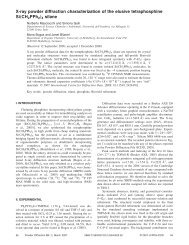
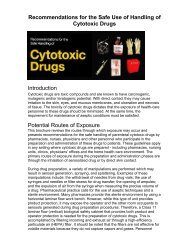
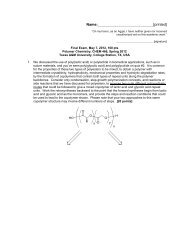

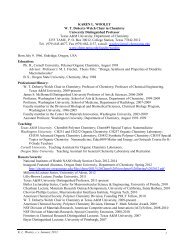
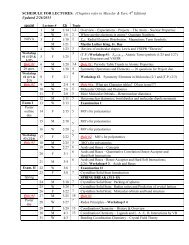
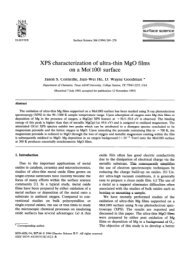
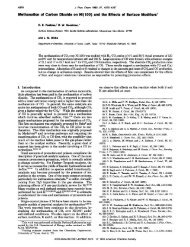
![Radical salts of TTF derivatives with the metal–metal bonded [Re2Cl8]](https://img.yumpu.com/10115211/1/190x253/radical-salts-of-ttf-derivatives-with-the-metal-metal-bonded-re2cl8.jpg?quality=85)



